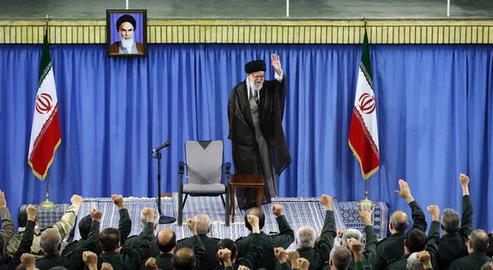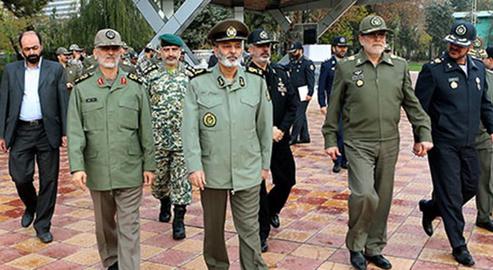The Revolutionary Guards: An Introduction
The Islamic Revolutionary Guard Corps (IRGC) is the Islamic Republic of Iran’s most important institution. The military-security institution commands huge influence in every aspect of Iranian public life, from culture and the environment to the economy, politics and judicial process. Whatever the field or area, the IRGC is not required to report to anybody and is answerable to no one.
The IRGC was created early after the 1979 Islamic Revolution by the order of the founder of the Islamic Republic, Ayatollah Ruhollah Khomeini. Its declared mission was to safeguard the revolution and its accomplishments. As the years have gone by, it has expanded its sphere of activities. The entities under its control have multiplied to such a degree that it now operates effectively as a parallel government. It interferes in all current affairs of the country and it aims to have control over every aspect of the way Iran is run.
In a series of reports, IranWire presents a detailed portrait of this powerful and mysterious institution and, for the first time, identifies and explains all bodies, institutions and other entities operating under the umbrella of the Revolutionary Guards, at the same time outlining its activities through an infographic and an interactive diagram.
The infographic is a visual representation of the Guards’ organizational structure and presents all institutions under the control of IRGC in one map. It resembles a family tree, a portrait of the IRGC with all its children, grandchildren and great-grandchildren — a dramatic picture of power in Iran today.
In the interactive diagram, the viewer is able to use the mouse to see how various entities under the control of the Guards emerged, and how they are connected — exactly like a family tree.
IranWire has aimed for this series and the overall project to be informative and a solid research tool. But it is not perfect, and there will always be room for updates, enhancements and further information. We welcome your views, ideas and knowledge, so please do get in touch via email, Twitter or Facebook.
***
The Commander in Chief of the Armed Forces (Farmandeh Kol-e Ghova)
The Supreme Leader is the commander in chief of the Armed Forces, which includes the IRGC (according to Article 110 of the Constitution). The leader appoints, fires and accepts the resignation letters of IRGC generals (as highlighted in Articles 1, 12, and 28 of the IRGC statute). The Supreme Leader’s authority is not limited to hiring and firing, he is also chief censor: “the content of the educational and political programs and publications shall be approved by the Supreme Leader or his representative in the IRGC” (Article 15 of the statute, ratified on September 6, 1982). The Supreme Leader’s representative in the force is automatically a member of the Command Council of the IRGC (Article 18), and the sessions are not formal unless he is present (Article 20). Currently, there is no report available on the IRGC Command Council’s activities, but its title exists in the statute and its name appears in different geographic areas and districts. As such, according to Saeid Golkar, a scholar and expert on Iran’s military and security forces, in particular the IRGC and the Basij, it can be safely said that the IRGC Command Council still exists at the general level. The Supreme Leader’s representative has his own office in the base and his role is to monitor all operations and activities in the IRGC (Article 27).
The Military Office of Commander in Chief of the Armed Forces (Daftar-e Nezami-ye Farmandehi-ye Kol-e Qova)
The office was established in 1989. Its chief is appointed by the Supreme Leader and is tasked with the administrative work involved in appointments and dismissals in the IRGC, as well as following up on the leader’s orders in the force. The office can be considered as an intermediate office between the Supreme Leader and the military entities.
The Ideological Political Office of Commander in Chief of the Armed Forces (Daftar-e Aghidati va Siasi-ye Farmandehi-ye Kol-e-Qova)
The Ideological Political Office of Commander in Chief of the Armed Forces, also run by the Supreme Leader, monitors power over the Supreme Leader’s representatives in the IRGC and other military units. The office is tasked with coordination between the leader’s orders and policies and the current plans and strategies in the force. The chief of office is appointed by the Supreme Leader and is in regular communication with the joint staff of the armed forces. The subunits of the office include a deputy chief, monitoring and investigation division, political division, training and education division, clerical affairs, and a cultural strategic center. Since 2017 and after the appointment of Ali Saedi as the chief, the office has experienced rapid growth in its reach of operations. Ali Saedi was the Supreme Leader’s representative in the IRGC prior to this position.
The General Office of Intelligence Protection of Commander in Chief of the Armed Forces (Daftar-e Omoumi-ye Hefazat va Ettelaat-e Farmandehi-e Kol-e Qova)
This office is an independent entity directly controlled by the Supreme Leader. It is tasked with coordination between various intelligence agencies active in the military forces and delivers the Supreme Leader’s orders and guidelines with respect to national security to those agencies. The office chief is appointed by the Supreme Leader and is head of the Intelligence Protection Policy-Making Council of the Islamic Republic’s Armed Forces and also a member of the country’s Intelligence Coordination Council.
The Strategic Studies Center of the IRGC (Markaz-eh Motalea’at-eh Rahbordi-eh Sepah)
The Strategic Studies Center of the IRGC was established on August 20, 2005, by order of the Commander in Chief of the Armed Forces Ayatollah Ali Khamenei. The mission of the center was stated as, “determining general directions and strategies for the IRGC.” The establishment of the center allows the IRGC to have all its strategies and policy-making within a single place. According to Chief Commander Jafari, some of the main duties of this center are to monitor changes in the Middle East region and design the strategies of future IRGC activities.
The Strategic Center of the IRGC has planned and executed many major programs such as changing the structure of the ground forces and the Basij, forming SWAT teams to fight against urban threats, and increasing the intelligence activities of the IRGC. It has also designed a program called, “Ghadir Strategic Plan.” Ghadir refers to a place where, according to Shias, Prophet Muhammad chose Ali, the 1st Imam of Shias as his successor in 632 AD. The Ghadir Plan includes 12 objectives and 51 strategies that include defining the IRGC’s mission, its doctrine, the threats against it and the organizational structure of the IRGC. The plan also defines a progress plan for the IRGC which includes 12 missions and 151 strategies. The plan has been implemented since 1999 by the order of the commander in chief of the Armed Forces.
The center has offices in some IRGC offices around the country and is expanding its operations. The center has also organized conferences and seminars, and published books. It’s first head was Mohammad Ali Jafari who was appointed chief commander in 2007. The Supreme Leader appointed Ali-Akbar Ahmadian as the new head, without taking the chief commander of the IRGC's recommendations into account or consulting with him. Based on such circumstantial evidence we can conclude that the center is directly under the control of the Supreme Leader.
Also in the series:
The Chief Commander of the IRGC
The Supreme Leader’s Representative in the IRGC
The IRGC Security and Intelligence Agencies
The IRGC's Social, Cultural, Scientific and Educational Institutions
The IRGC Commercial and Financial Institutions-(Khatam-al-Anbiya Construction Headquarters)
The IRGC Commercial and Financial Institutions-(Bonyad-e Ta’avon-e Sepah)
The Organization for the Mobilization of the Oppressed
The Basij Cooperative Foundation
Cyberspace Institutions and The Physical Training Organization of the Basij
Basij Headquarters and Military Organizations
The Islamic Revolutionary Guards Corps: Structure and Missions
visit the accountability section
In this section of Iran Wire, you can contact the officials and launch your campaign for various problems


























comments